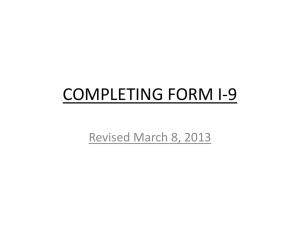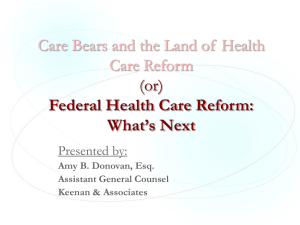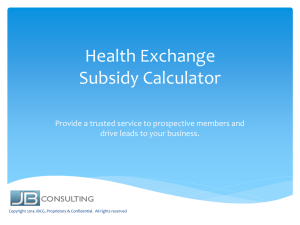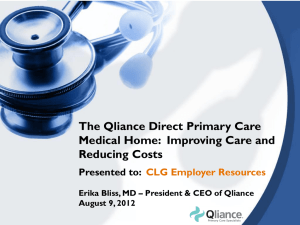Denny Ebersole Presentation - Jefferson Chamber of Commerce
advertisement
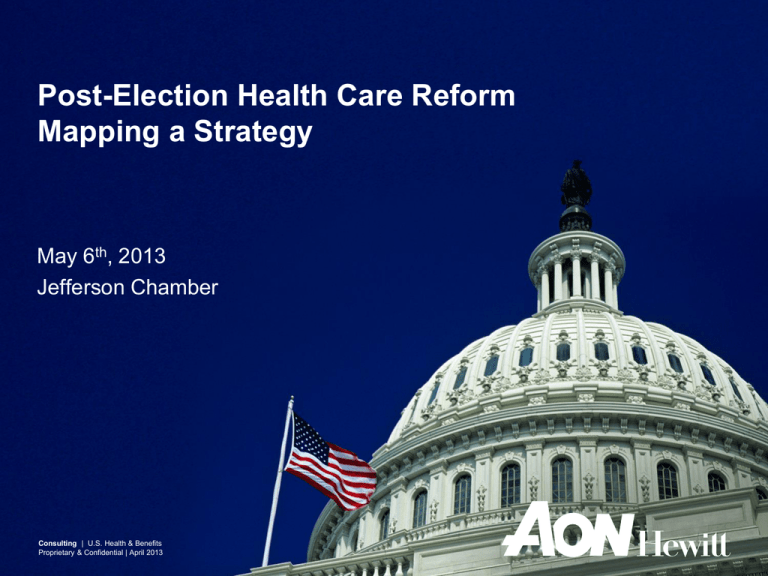
Post-Election Health Care Reform Mapping a Strategy May 6th, 2013 Jefferson Chamber Consulting | U.S. Health & Benefits Proprietary & Confidential | April 2013 The Future of U.S. Health Care Coverage Expanding/Improving Coverage Paying for Expanded Coverage Health Insurance Exchanges with Reformed Rules Federal Subsidies To Buy Health Insurance In Exchanges Medicare/Medicaid Payment Changes ACA Penalties on Employer Optional State Expansion of Medicaid “Individual Mandate”—now a “Shared Responsibility Payment” Increased Medicare Taxes on HighIncome Individuals Increase in Other Taxes Employer Mandate Taxation of High-Cost Employer Health Care Coverage = Direct impact to employers = Indirect impact to employers = Direct and indirect impact to employers 1Supreme 2Supreme Court ruled states could decline to expand Medicaid eligibility without losing existing Medicaid funding Court ruled “mandate” is a tax on not having health insurance Consulting | U.S. Health & Benefits Proprietary & Confidential | April 2013 1 Major ACA Provisions—Fees Direct Employer Fees – Patient Centered Outcomes Research Institute (PCORI) • per member annual fee of $1 in 2012, $2 in 2013 – Transitional Reinsurance Fee -cover reinsurance programs in state exchanges • $12B in 2014 • $8B in 2015 • $5B in 2016 Indirect Employer Impacts – Fees on pharmaceutical companies and medical device manufacturers, effective 2011 and 2013. – Fees on health insurers, effective 2014 Consulting | U.S. Health & Benefits Proprietary & Confidential | January 2013 ACA Timeline—2011 to 2018 2011 Plan Year Lifetime dollar limits on Essential Health Benefits (EHB) prohibited* Preexisting Condition Exclusions Prohibited for Children under 19* Overly restrictive annual dollar limits on EHB prohibited* Extension of Adult Child Coverage to Age 26* Prohibition on Rescissions* No Cost Sharing and Coverage for Certain In-Network Preventive Health Services** Effective Appeals Process** Consumer/patient protections** Nondiscrimination requirements on fully insured plans** (DELAYED) Certain Retiree Medical Claims Reimbursable (ERRP) Retiree Drug Plan FAS Liability Recognition 2011 Over-the-Counter Medicines Not Reimbursable Under Health FSA, HRAs, or from HSAs Without a Prescription, Except Insulin HSA Excise Tax Increase Public Long-Term Care Option (CLASS Act) –No Longer Supported by HHS Medicare Part D Discounts for Certain Drugs in “Donut Hole” Aon Hewitt | Health & Benefits Consulting Proprietary & Confidential | January 2013 2012 Employer Distribution of Summary of Benefits and Coverage to Participants* Comparative Effectiveness Fee Employer Quality of Care Report** Medical Loss Ratio rebates (insured plans only)* Employer Reporting of Health Coverage on Form W-2 (due January 31, 2013) 2013 Notice to Inform Employees of Coverage Options in Exchange Limit of Health Care FSA Contributions to $2,500 (Indexed) Elimination of Deduction for Expenses Allocable to Retiree Drug Subsidy (RDS) Medicare Tax on High Income Addition of women’s preventive health requirements to No Cost Sharing and Coverage for Certain In-Network Preventive Health Services ** *Denotes group/insurance market reforms applicable to all group health plans. **Denotes group/insurance market reforms not applicable to grandfathered health plans. *** This requirement applies to full time employees (e.g., 30 hours per week) and will require coverage that is affordable and satisfies a certain actuarial value to avoid the penalty. Guidance forthcoming. 2014 2018 Individual Mandate to Excise Tax on Purchase Insurance or High-Cost Pay Penalty Coverage State Insurance Exchanges Employer Responsibility to Provide Affordable Minimum Essential Health Coverage*** Preexisting Conditions Exclusions Prohibited* Annual Dollar Limits on EHB Prohibited* Automatic Enrollment Limit of 90-Day Waiting Period for Coverage* Employer Reporting of Health Insurance Information to Government and Participants Increased Cap on Rewards for Participation in Wellness Program** Cost-sharing limits for all group health plans, not just HDHPs/HSA (deductibles and OOP maximum)** 3 Transitional reinsurance fees State vs. Federal Exchange: A State-by-State Look Source: Kaiser Family Foundation Consulting | U.S. Health & Benefits Proprietary & Confidential | January 2013 4 Compliance Issues—2013 and 2014 2013 Employer must determine FTEs to avoid ACA penalties for not offering health care coverage Notice informing employees of coverage options in exchange Limit health care FSA contributions to $2,500 (Indexed) Elimination of deduction for expenses allocable to retiree drug subsidy (RDS) Additional 0.9% Medicare tax on high income earners 3.8% Medicare tax on investment income of high income earners Addition of women’s preventive health requirements of no cost sharing and coverage for certain in-network preventive health services PCORI Fee ($2 PMPY) Consulting | U.S. Health & Benefits Proprietary & Confidential | January 2013 2014 Employer must provide affordable health care coverage to FTEs or risk penalty Individuals must buy health care or pay tax State insurance exchanges begin Preexisting condition exclusions prohibited Annual dollar limits on EHB prohibited Automatic enrollment (guidance delayed) Maximum 90-Day Waiting Period for Coverage Employer Reporting of Health Insurance Information to Government and Participants Increased Cap on Rewards for Participation in Wellness Program Cost-sharing limits for all group health plans, not just HDHPs/HSA (deductibles and OOP maximum) PCORI Fee ($2 PMPY) Transitional reinsurance fees ($63 PMPY) 5 How the ACA Penalties Works Employer can be liable for either a “Doomsday Penalty” or a “Targeted Penalty” “Doomsday Penalty” – Employer does not offer Minimum Essential Coverage to all FTEs (and their eligible dependents) and at least one FTE enrolls in an Exchange and receives a Federal subsidy • NEW: “All FTEs” changed to “95% of FTEs” • NEW: dependent coverage must be offered but does not have to meet affordability rules (dependent defined as children up to age 26, no spouses) – “Doomsday Penalty” applies • $2,000 per year per each FTE (minus first 30 FTEs) Regardless of whether the FTE elected employer-provided health care coverage • NEW: penalty not assessed on Control Group, only on the offending subsidiary/entity Consulting | U.S. Health & Benefits Proprietary & Confidential | January 2013 6 Determining Full Time Employees Under the ACA Establish measurement period – Period of time over which employer tracks employee’s hours of service • Cannot be less than three months or more than twelve months in duration – Initial measurement period for new employees will be based on each employee’s start date – Standard measurement period for ongoing employees will be a uniform period of time set by employer Establish administrative period—optional (up to 90 days in duration) – Employer looks back at employee’s hours of service in measurement period • Did employee work an average of 30 hours per week during measurement period? If yes, then employee is a FTE If no, then employee is not a FTE and employer has to keep tracking hours of service in next measurement period Establish stability period – Period of time for which employer must offer coverage to FTE to avoid ACA penalties • Stability period must be at least as long as measurement period, but not less than six months – If not an FTE in measurement period, stability period cannot exceed measurement period • NEW*: Exception for transition measurement period in 2013 which can be as short as six months * Proposed regulations released 12/28/12 Consulting | U.S. Health & Benefits Proprietary & Confidential 7 Defining FTE Status of Ongoing Employees Measurement Period (MP) Administrative Period (AP) Stability Period (SP) 3 – 12 months Up to 90 days At least 6 months but no shorter than MP (exception allowed for transition) Determines offer of health care coverage for stability period Average hours worked (exception allowed for transition) Buffer between MP and SP Allows for measuring and enrolling full-timers Measurement Period Considerations Longer period reduces number of full-timers given high turnover Shorter period provides more time to make workforce adjustments to mitigate cost Eligibility period for employees averaging 30 hours or more during MP Stability Period Considerations Shorter period reduces coverage commitment but creates administrative complexity Longer period that aligns with calendar years is most practical administratively Sample Periods for January 1, 2014 Plan Year using transition relief Measurement Period: April 1 – September 30, 2013 (6 months) Administrative Period: October 1 – December 31, 2013 (90 days) Stability Period: January 1, 2014 – December 31, 2014 Consulting | U.S. Health & Benefits Proprietary & Confidential 8 Is a New Hire an FTE? Is the New Hire Reasonably Expected to Work Full-Time at Start Date? – If a new hire is reasonably expected to work full-time, then the employer can avoid free rider penalty by offering coverage at or before FTE’s first 3 months of employment Is the New Hire a Variable Hour Employee at Start Date? – Look at the “facts and circumstances” – A new employee is a variable hour employee if • It cannot be determined that the employee is reasonably expected to work on average at least 30 hours/week or • The initial period of 30 hours/week employment is reasonably expected to be of limited duration and it cannot be determined that the employee is reasonably expected to work on average at least 30 hours/week over the initial measurement period; e.g.: Retail worker hired at more than 30 hours/week for the holiday season but who is reasonably expected to work fewer than 30 hours/week after the holiday season Part-time worker hired for 20 hours per week but who could work more Is the New Hire a Seasonal Employee? – Reasonable, good faith interpretation of the term “seasonal employee” through at least 2014 Consulting | U.S. Health & Benefits Proprietary & Confidential 9 Defining FTE Status of Newly Hired Employees New Variable Hour and Seasonal Employees Initial Measurement Period (IMP) Administrative Period (AP) Stability Period (SP) 3 – 12 months Up to 90 days Same length as ongoing employees Considerations IMP plus AP must not last beyond last day of 1st calendar month following employee’s one-year anniversary – No more than 13 months plus a partial month Transition to ongoing allows for extension of coverage for balance of overlapping ongoing stability period Administrative capabilities/limitations will weigh heavily on length of MP/AP decision Consulting | U.S. Health & Benefits Proprietary & Confidential 10 Employer Penalty Issues Who is a “full-time employee”? – Employee who works 30 hours or more per week, measured monthly – 130 hours of service in a calendar month is treated as monthly equivalent of 30 hours of service per week What is “unaffordable coverage?” – Employer plan is unaffordable if the FTE’s required contribution exceeds 9.5% of taxpayer’s household income for the taxable year • Employer may calculate affordability using FTE’s W-2 wages (Box 1) • NEW: Two additional safe harbors for affordability determination: Lowest rate of pay 9.5% of Federal poverty line (about $90 per month for single coverage) – Affordability is based on cost of self-only coverage, even if employee elects family coverage What is “minimum actuarial value?” – Plan must pay at least 60% of covered expenses – Guidance recently provided from IRS on minimum actuarial value Consulting | U.S. Health & Benefits Proprietary & Confidential | January 2013 11 Safe Harbor for New Hire—FTE in Initial Measurement Period New hire on February 1, 2013 works 30 hours per week in initial measurement period and is entitled to health care coverage during initial stability period Employer then tracks hours during standard measurement period to determine whether he is entitled to coverage in ongoing stability period Initial Measurement Period (IMP)* 2/1/2013 to 1/31/2014 Admin Period* 2/1 to 2/28 2014 *IMP must be between 3 and 12 months *IMP+ AP < 13 months Initial Stability Period (ISP)* 3/1/2014 to 2/28/2015 Stability Period (1/1/15 to 12/31/15) *must be same duration as for ongoing employees Standard Measurement Period 10/15/2013 to 10/14/2014 (overlaps with ISP) Consulting | U.S. Health & Benefits Proprietary & Confidential If not FTE in SMP, then continue coverage for ISP, but no coverage for Stability Period Admin Period Stability Period (1/1/15 to 12/31/15) 10/15 to 12/31 2014 If FTE in SMP, FTE is entitled to coverage for this stability period 12 Safe Harbor for New Hire—Not an FTE in Initial Measurement Period New hire on February 1, 2013 does not work 30 hours per week in initial measurement period and is not entitled to health care coverage during initial stability period Employer then tracks hours during standard measurement period to determine whether he is entitled to coverage in ongoing stability period Initial Measurement Period 2/1/2013 to 1/31/2014 Admin Period for IMP 2/1 to 2/28 2014 Does not work 30 hrs/wk Initial Stability Period (ISP) Stability Period (1/1 to 12/31/2015) 3/1/2014 to 2/28/2015 No coverage for ISP; if not FTE in SMP, no coverage in Stability Period Not FTE no coverage—but see below* Admin Period for SMP Standard Measurement Period (SMP) 10/15/2013 to 10/14/2014 (overlaps ISP) Consulting | U.S. Health & Benefits Proprietary & Confidential 10/15 to 12/31 2014 Stability Period (1/1 to 12/31/2015) *If FTE in SMP, FTE is entitled to coverage for this stability period 13 Other FTE Determination Rules Employers may vary Measurement Periods and Stability Periods for following categories of employees – Union and Non-Union – Salaried and Non-Salaried – Employees of different entities – Employees located in different states Employer is not required to offer coverage to any particular employee or class of employees, including part-time employees – However, an otherwise eligible employee (or dependent) cannot be required to wait more than 90 days before coverage becomes effective Eligibility conditions based solely on the lapse of time cannot be longer than 90 days – the employer cannot impose a waiting period that conditions enrollment on the first day of the month after completing 90 days Employer may condition eligibility on an employee regularly working a specified number of hours per period (or working full time) – the employer may take a reasonable period of time to determine whether the employee meets the plan’s eligibility condition Consulting | U.S. Health & Benefits Proprietary & Confidential 14 What is an Exchange? An exchange is a competitive marketplace that consists of suppliers and buyers Exchange Expedia Amazon iTunes Consulting | U.S. Health & Benefits Proprietary & Confidential | January 2013 How Corporate Exchanges Work Consulting | U.S. Health & Benefits Proprietary & Confidential | January 2013 16 Plan Design Highlights Bronze Bronze Plus Silver Gold Platinum $2,750 / $5,500 $2,000 / $4,000 $1,500 / $3,000 $600 / $1,200 None 20% 20% 20% 10% 0% $3,750 / $7,500 $3,000 / $6,000 $1,500 / $3,000 Medical Plan Design INN Deductible (single/family) INN Coinsurance INN OOP max (inc ded) $5,950 / $11,900 $5,000 / $10,000 Hospital Inpatient Per Admission 20% 20% 20 10% $250 Copayment Primary Care / Specialist 20% 20% 20% $20 / $35 Copayment $20 / $35 Copayment Emergency Room 20% 20% 20% 10% $100 Copayment Included w/ medical Included w/ medical Included w/ medical N/A N/A Retail Generic 20% 20% 20% $5 Copay $4 Copay Retail Brand Formulary 20% 20% 20% 20% (up to $50 maximum) $20 Copay Retail Brand NonFormulary 20% 20% 20% 40% (up to $100 maximum) $40 Copay Actuarial Value 66% 71% 75% 81% 92% Rx Plan Design Deductible & OOP Maximum Aon Hewitt | Health & Benefits Proprietary & Confidential | 2013 17 Which Path to Take? Consumerism Health Improvement Consulting | U.S. Health & Benefits Proprietary & Confidential | January 2013 Still About An Evolving Health Care System Individual Solutions System Overload Rapid Consolidation Health Plans Providers Broad Adoption Technology Insureds US Health Care System More Strategic Options Exchanges New Normal Employers Consulting | U.S. Health & Benefits Proprietary & Confidential | January 2013 Government programs Expanded Coverage 19 Speakers Denny Ebersole Denny.Ebersole@AonHewitt.com O: 504-681-2103 C: 504-451-0886 Consulting | U.S. Health & Benefits Proprietary & Confidential 20

